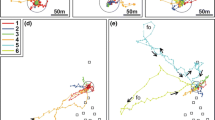Abstract
We investigated the ability of bees to associate a motor parameter with a sensory one. Foragers were trained to fly along a prescribed route through a large box which was partitioned into compartments. Access from one compartment to the next was through a hole in each partition. In two of the compartments, the back wall was covered with a grating of black and white stripes. Stripe orientations and the required trajectories differed in the two compartments so giving bees the opportunity to learn that one stripe orientation signalled the need to fly leftwards and the other rightwards.
We videotaped the bees' trajectories through one of these compartments in tests with the grating on the back wall in one of four possible orientations. Flight trajectories to stripes in the training orientations were appropriately to the left or to the right implying that bees had linked a given flight direction to a given stripe orientation. With gratings oriented between the training values, flight directions were, under some conditions, intermediate between the training directions. This interpolation indicates that the training regime had induced a continuous mapping between stripe orientation and trajectory direction and thus suggests that trajectory direction is a motor parameter which is encoded explicitly within the brain. We describe a simple network that interpolates much like bees and we consider how interpolation may contribute to the ability of bees to navigate flexibly within a familiar environment.
Similar content being viewed by others
References
Batschelet E (1981) Circular statistics in biology. Academic Press, London
Cartwright BA, Collett TS (1987) Landmark maps for honeybees. Biol Cybern 57: 85–93
Collett TS (1992) Landmark learning and guidance in insects. Phil Trans R Soc Lond B 337: 295–303
Collett TS, Baron J (1994) Biological compasses and the coordinate frame of landmark memories in honeybees. Nature 368: 137–140
Collett TS, Fry SN, Wehner R (1993) Sequence learning by honeybees. J Comp Physiol A 172: 693–706
Dyer FC (1991) Bees acquire route-based memories but not cognitive maps in a familiar landscape. Anim Behav 41: 239–246
Dyer FC (1993) How honey bees find familiar feeding sites after changing nesting sites with a swarm. Anim Behav 46: 813–816
Dyer FC, Berry NA, Richard AS (1993) Honey bee spatial memory: use of route-based memories after displacement. Anim Behav 45: 1028–1030
Frisch K von (1967) The dance language and orientation of bees. Belknap, Harvard, Cambridge, Mass
Georgopoulos AP (1994) New concepts in generation of movement. Neuron 13: 257–268
Gould JL (1986) The locale map of honey bees. Do insects have cognitive maps? Science 232: 861–863
Hebb DO (1949) The organization of behavior. Wiley, New York
Heinrich B (1976) Foraging specializations of individual bumblebees. Ecol Monogr 46: 105–128
Janzen DH (1971) Euglossine bees as long-distance pollinators of tropical plants. Science 171: 203–205
Salzman CD, Newsome WT (1994) Neural mechanisms for forming a perceptual decision. Science 264: 231–237
Schmidt I, Collett TS, Dillier F-X, Wehner R (1992) How desert ants cope with enforced detours on their way home. J Comp Physiol A 171: 285–288
Srinivasan MV, Zhang SW, Witney K (1994) Visual discrimination of pattern orientation by honey bees: performance and implications for ‘cortical’ processing. Phil Trans R Soc Lond B 343: 199–210
Wehner R (1971) The generalization of directional visual stimuli in the honey bee, Apis mellifera. J Insect Physiol 17: 1579–1591
Wehner R (1992) Arthropods. In: Papi F (ed) Animal homing. Chapman & Hall, London, pp 45–144
Wehner R, Menzel R (1990) Do insects have cognitive maps? Annu Rev Neurosci 13: 403–414
Wehner R, Bleuler S, Nievergelt C, Shah D (1990) Bees navigate by using vectors and routes than maps. Naturwissenschaften 77: 479–482
Author information
Authors and Affiliations
Rights and permissions
About this article
Cite this article
Collett, T.S., Baron, J. Learnt sensori-motor mappings in honeybees: interpolation and its possible relevance to navigation. J Comp Physiol A 177, 287–298 (1995). https://doi.org/10.1007/BF00192418
Accepted:
Issue Date:
DOI: https://doi.org/10.1007/BF00192418




